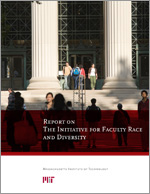Report of the Initiative for Faculty Race and Diversity
Appendices
Appendix 1 – Interview Protocol
Appendix 2 – Details of the Minority Interview Sample
Appendix 3 – Details of the Survey Sample
Appendix 4 – Details of Cohort Analysis
Appendix 5 – Salary Analysis
Appendix 1
Interview Protocol16
During this interview I will ask you about the circumstances that brought you to MIT, your experiences at this institution, your observations about the campus climate (climate of inclusion) at MIT, your family and social life. I anticipate that this interview will take 90-120 minutes. Unless you have any objections, I would like to record this interview. Only the members of the research team will have access to the audio-recorded interviews and at no time will your name or any identifying information be disclosed. Before we begin, do you have any questions for me?
FACULTY INFORMATION
«Full Name»
«Age»
«Gender»
Name (last, first)
Age
Gender
«Ethnic Origin in HR»
______________
____________
Racial Background
Country of Origin
Years in U.S.
«Position Title»
____________________
Academic Rank
Discipline/Academic Field
Position Title(s)______________________________________________________
___________________________________________________________________
«Date To Faculty»
«Tenure Date Year»
Years as Faculty Member at MIT
Tenure Year
Y/N
«HR Department Name»
Served as Department Chair
Academic Department
Do you have a chair?
(Y/N)
Please indicate what kind of chair? ___________________________
__________________________________________________________________
Where did you get your undergraduate degree(s)? ___________________
__________________________________________________________________
Where did you get your graduate degree(s)? ____________________
__________________________________________________________________
Do you have a spouse/partner?
(Y/N)
Do you have any children?
(Y/N)
Do you have children under the age of 18 living with you?
(Y/N)
COMING TO MIT
- Describe your educational history/trajectory? (tie back to first page)
- How were you first introduced to « name of field from first page »? (What attracted you to the field and to teaching in the field?)
- I understand that you joined the MIT faculty in «Date To Faculty»? What were the circumstances that led to you joining MIT? (applied or recruited?) (did race play any role?)
- Tell us about your subsequent experiences upon joining MIT. (What was your experience when you first arrived? Were you welcomed? Mentored? Resources provided?)
EXPERIENCES OVER TIME
- What has life at MIT been like since you arrived? (Work group, department, school, institute)
- What critical incidents or specific environments have shaped your experiences at MIT? (Work group, department, school, institute? Promotion and tenure?)
- Since coming to MIT have you been mentored? (may have been answered by question 4 in first section)
- Have your experiences changed over time? If so, how? (pre-tenure vs. post-tenure)
- Now that you have tenure, what is your life like? How does it compare to pre-tenure?
- Do you feel there is a difference between the ways your work is perceived at MIT as opposed to the national or international arena of your field? Are you and your work (research, teaching and service) valued at MIT? How do you know that they are or are not?
- Do you perceive your presence at MIT to be under continual challenge? If so, how do you maintain perspective about yourself and your work?
- Have you received other offers since arriving at MIT? Did MIT make a counter-offer? What led you to stay?
RACIAL EXPERIENCES
- Does race factor into your experiences at MIT? If so how?
- Can you characterize the ways in which you have experienced racial incidents? Have you ever faced/experienced difficulties at MIT/in your department you feel/felt were related to race? (Do you feel/have you ever felt isolated?)
- What role did race play in your hiring/coming to MIT?
- Have you witnessed the impact of race in the experiences of other colleagues of color at MIT? (Please give specific examples/no names necessary)
- Do you have any formal/informal ways that you work with URM students?
CLIMATE OF INCLUSION
- How would you characterize the climate of inclusion (campus climate) at MIT? (Would you say the same for your work group, department, school, and institute?)
- How do you think MIT sees the connection between diversity and excellence? How do you see it?
- In what ways have you witnessed changes in the climate of inclusion (campus climate) at MIT?
- Are there unique challenges in the MIT culture that shape the climate of inclusion (campus climate)? If so what are they?
- How can the climate of inclusion (campus climate) be improved at MIT?
- Have you ever worked at an educational institution other than MIT? If you have, how is the campus climate (climate of inclusion) similar/different from that other institution? (Note that for many a relevant comparison may also be the alma mater of the interviewee)
- Do you have any thoughts/reactions to the use of currently available MIT initiatives such as MLK or Target Opportunity hires by your department? (Affirmative Action)
FAMILY, COMMUNITY AND SOCIAL LIFE
- Has your family life impacted your work life at MIT? If so, how?
- Do you feel youve achieved a comfortable integration between home and work life? How do you negotiate the two? Describe you social life within the dept, school, city? How do you negotiate life at MIT/outside of MIT?
- What informed your decisions about where you live? (length of travel?) (How did race play into these decisions?)
- Who is in your support system? How did they get there?
- Do you have a community outside of MIT/has this changed over the time you are at MIT? Do you feel your achievements have created a distance between you and the people in your earlier life?
FINAL QUESTIONS
- In your opinion, if this research could ensure one result/outcome, what would that be?
- Some people have brought up the James Sherley incident? Do you have any thoughts on that?
- Is/Are there any other topic(s) or issue(s) that come to mind that you would like to share with us, or that I should have addressed, but overlooked?
Appendix 2
Details of the Minority Interview Sample
Table 2.1
Descriptive statistics17
|
Black |
Hispanic |
|
|
Sex |
||
|
Women |
9 (35%) |
2 (10%) |
|
Men |
17 (65%) |
18 (90%) |
|
Rank |
||
|
Assistant |
10 (38.5%) |
9 (45%) |
|
AWOT |
2 (8%) |
4 (20%) |
|
AWIT |
4 (15%) |
1 (5%) |
|
Full |
10 (38.5%) |
6 (30%) |
|
Has a chair |
7 (27%) |
11 (55%) |
|
School |
||
|
Engineering |
12 (46%) |
8 (40%) |
|
Science |
1 (4%) |
3 (15%) |
|
SHASS |
8 (31%) |
2 (10%) |
|
SAP |
3 (11%) |
1 (5%) |
|
Sloan |
2 (8%) |
6 (30%) |
|
Country of Origin |
||
|
USA |
20 (77%) |
8 (40%) |
|
South America (U.S. undergrad) |
1 (5%) |
|
|
South America (So. Am. undergrad) |
6 (30%) |
|
|
Africa |
3 (11%) |
|
|
Non-U.S. islands (U.S. undergrad) |
2 (8%) |
1 (5%) |
|
Mexico |
3 (15%) |
|
|
Europe |
1 (4%) |
1 (5%) |
Table 2.2
Graduate schools feeding faculty in interview sample (n=47)
|
Institution |
Frequency |
Percentage |
|
MIT |
10 |
21% |
|
Harvard |
9 |
19% |
|
Stanford |
9 |
19% |
|
Yale |
2 |
4% |
|
Univ. of Chicago |
2 |
4% |
|
UC-Berkeley |
2 |
4% |
|
International |
2 |
4% |
|
Other |
11 |
23% |
Note: Applies to schools from which faculty received a Ph.D. If faculty member has more than one degree from any institution, the institution was counted only once.
Note: Other includes Caltech, Cornell, CUNY, Julliard, Northwestern, NYU, Princeton, UCSB, Univ. of Michigan, Univ. of Pennsylvania & Univ. of Virginia
Appendix 3
Details of the Survey Sample
Table 3.1
Descriptive statistics*
|
White |
Asian |
Black |
Hispanic |
|
|
Sex |
||||
|
Women |
117 (20%) |
21 (27%) |
9 (38%) |
1 (7%) |
|
Men |
455 (80%) |
58 (73%) |
15 (62%) |
13 (93%) |
|
Rank |
||||
|
Asst |
87 (15%) |
23 (29%) |
11 (46%) |
6 (43%) |
|
AWOT |
40 (7%) |
7 (9%) |
1 (4%) |
3 (21%) |
|
AWIT |
70 (12%) |
14 (18%) |
4 (17%) |
2 (14%) |
|
Full |
359 (63%) |
34 (43%) |
8 (33%) |
3 (21%) |
|
PWOTR** |
16 (3%) |
1 (1%) |
0 |
0 |
|
School*** |
||||
|
Engineering |
212 (38%) |
32 (42%) |
10 (42%) |
5 (36%) |
|
Science |
152 (27%) |
20 (26%) |
1 (4%) |
4 (29%) |
|
SHASS |
103 (18%) |
10 (13%) |
8 (33%) |
2 (14%) |
|
SAP |
47 (8%) |
8 (10%) |
3 (12%) |
0 |
|
Sloan |
51 (9%) |
7 (9%) |
2 (8%) |
3 (21%) |
* One Native American respondent is not included, as are the 18 people who did not self-identify or chose a different race/ethnicity category altogether
** Professor Without Tenure, Retired counted as tenured
*** Nine people (seven White and two Asian) did not provide information on school
Note: The survey has the best information on faculty background that we have available, though there are some system records on citizenship. Sadly, though, the response rate was not as high as we would like, especially not among Hispanics, and a number of respondents did not even answer some of these questions. Hence this table is incomplete but presents the best data we have.
|
Country of birth |
White |
Asian |
Black |
Hispanic |
|
U.S. |
319 (67%) |
15 (22%) |
15 (75%) |
5 (45%) |
|
Citizenship* |
(n=551) |
(n=75) |
(n=22) |
(n=14) |
|
U.S. |
416 (75%) |
39 (52%) |
20 (91%) |
5 (36%) |
|
If not U.S. born, when |
(n=157)** |
(n=53)*** |
(n=5) |
(n=6) |
|
<= high sch |
18 (11%) |
7 (13%) |
1 (20%) |
0 |
|
college |
12 (8%) |
12 (23%) |
1 (20%) |
0 |
|
grad school |
83 (53%) |
31 (58%) |
3 (60%) |
6 (100%) |
|
1st profsl job |
38 (24%) |
3 (6%) |
0 |
0 |
* Citizenship came from system records
** Two White faculty not born in the U.S. did not answer this question; six White faculty answered other
*** One Asian faculty not born in the U.S. did not answer this question
Table 3.3
Overall, how satisfied are you being a faculty member at MIT?*
|
Tenured faculty |
White |
Asian |
Black |
Hispanic |
|
Dissatisfied** |
66 (15%) |
10 (21%) |
3 (25%) |
2 (40%) |
|
Neutral |
14 (3%) |
2 (4%) |
0 |
0 |
|
Somewhat satisfied |
129 (30%) |
12 (26%) |
3 (25%) |
1 (20%) |
|
Very satisfied |
222 (51%) |
23 (49%) |
6 (50%) |
2 (40%) |
|
Untenured faculty |
(n=127) |
(n=30) |
(n=12) |
(n=8) |
|
Dissatisfied** |
23 (18%) |
1 (3%) |
2 (17%) |
0 |
|
Neutral |
7 (6%) |
0 |
0 |
1 (12.5%) |
|
Somewhat satisfied |
37 (29%) |
12 (40%) |
2 (17%) |
2 (25%) |
|
Very satisfied |
60 (47%) |
17 (57%) |
8 (67%) |
5 (62.5%) |
*One Native American respondent is not included
**Includes very and somewhat dissatisfied
Note: 17 people (14 White, 2 Asians and 1 Hispanic) did not answer this question
Appendix 4
Details of Cohort Analysis
- 4.1 Descriptive statistics
- 4.2 Estimates from linear probability and logit models of effect of URM on promotion to AWOT
- 4.3 Survival analysis
- 4.4 Hiring over time
- 4.5 Timing to AWOT, tenure, and from tenure to full
- 4.6 Leaving MIT over time
Note: The leaving figures do not come from the cohort data set, since they display people who have left MIT independent of when they were hired. The cohort data set is limited to those who were hired between 1991 and 2009.
Table 4.1
Descriptive statistics
(cohort data set: all those hired 1991-2009)
|
URM* |
White |
Asian |
Black |
Hispanic |
|
|
Sex |
|||||
|
Women |
23 (30%) |
166 (24%) |
38 (28%) |
16 (38%) |
5 (15%) |
|
Men |
54 (70%) |
532 (76%) |
97 (72%) |
26 (62%) |
28 (85%) |
|
School** |
|||||
|
Enging |
25 (32%) |
205 (29%) |
43 (32%) |
14 (33%) |
11 (33%) |
|
Science |
8 (10%) |
191 (27%) |
38 (28%) |
4 (10%) |
3 (9%) |
|
SHASS |
22 (29%) |
135 (19%) |
21 (16%) |
14 (33%) |
7 (21%) |
|
SAP |
6 (8%) |
78 (11%) |
15 (11%) |
4 (10%) |
2 (6%) |
|
Sloan |
16 (21%) |
87 (13%) |
17 (13%) |
6 (14%) |
10 (30%) |
|
Rank at hire |
|||||
|
Asst |
65 (84%) |
547 (78%) |
112 (83%) |
35 (83%) |
28 (85%) |
|
AWOT |
8 (10%) |
47 (7%) |
5 (4%) |
4 (10%) |
4 (12%) |
|
AWIT |
0 |
31 (4%) |
6 (4%) |
0 |
0 |
|
Full |
4 (5%) |
73 (10%) |
12 (9%) |
3 (7%) |
1 (3%) |
|
% still at MIT |
38% |
37% |
30% |
40% |
33% |
*Includes 2 Native Americans
**Two White and 1 Asian faculty are not in any school
Table 4.2
Estimates from linear probability and logit models
of effect of URM on promotion to AWOT
(assistant professors hired 1991-2004)
|
Linear Probability Model |
(Model 1) |
(Model 2) |
(Model 3) |
|
URM |
0.187* |
0.172* |
|
|
(0.083) |
(0.072) |
||
|
Asian |
0.039 |
0.033 |
0.033 |
|
(0.050) |
(0.050) |
(0.050) |
|
|
Female |
0.074 |
0.048 |
0.046 |
|
(0.045) |
(0.045) |
(0.045) |
|
|
URM non-U.S. origin |
0.127 |
||
|
(0.135) |
|||
|
URM U.S. origin |
0.188* |
||
|
(0.084) |
|||
|
(year of entry) |
(year of entry) |
||
|
R-squared |
0.020 |
0.183 |
0.183 |
|
Observations |
554 |
554 |
554 |
|
Logit Marginal Effects |
|||
|
URM |
0.184* |
0.197* |
|
|
(0.083) |
(0.086) |
||
|
Asian |
0.040 |
0.03 |
0.036 |
|
(0.052) |
(0.054) |
(0.054) |
|
|
Female |
0.075 |
0.051 |
0.050 |
|
(0.045) |
(0.049) |
(0.050) |
|
|
URM * non-U.S. origin |
0.160 |
||
|
(0.151) |
|||
|
URM * U.S. origin |
0.213* |
||
|
(0.102) |
|||
|
(year of entry) |
(year of entry) |
||
|
Observations |
554 |
518 |
518 |
Robust standard errors in parentheses.
* p<0.05, ** p<0.01, *** p<0.001
Logit marginal effects are average derivatives derived from the estimated logit conditional mean function.
Logit estimates exclude department/year cells where the model fits perfectly.
Figure 4.3
Survival probability plots
(Those who began as Assistant Professors, 1991-2009) (N=715)
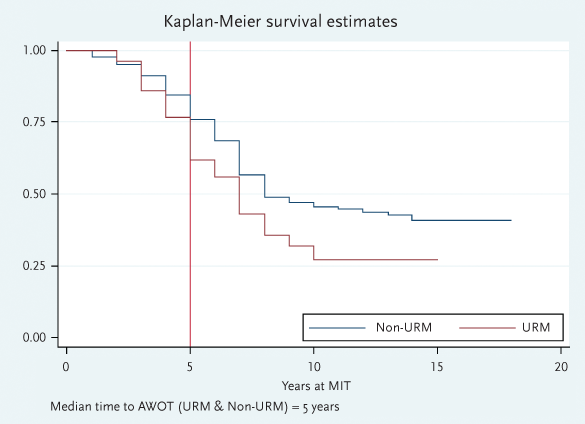
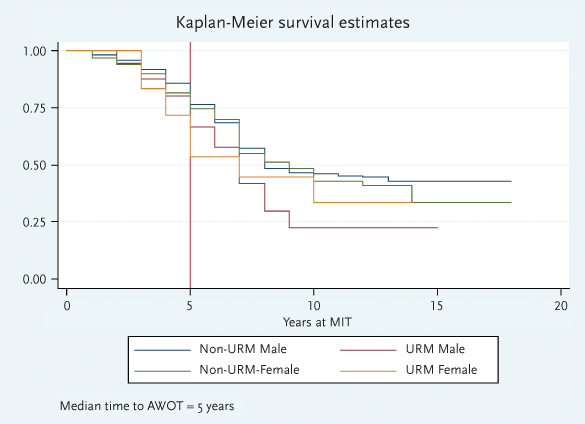
Note: These graphs show the probability that a newly hired Assistant Professor still works at MIT as a function of time since hire.
Figure 4.4.1
Faculty hired from 19912009 by race/ethnicity
(Rolling 3-year sums)
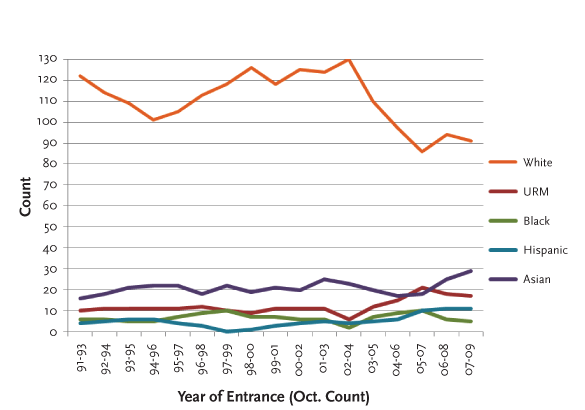
Figure 4.4.2
Faculty hired from 19912009, URM faculty
(Rolling 3-year sums)
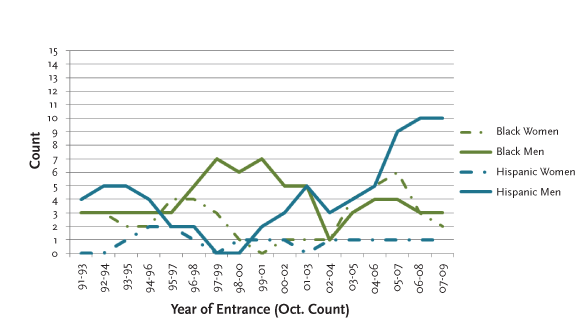
Table 4.5
Mean times to AWOT, tenure, and from tenure to full
(of those hired as assistant professors)
|
Time to AWOT |
Time to tenure |
Time from tenure to full |
|
|
Cohort used |
(1991-2004) |
(1991-2000) |
(1991-1997) |
|
URM |
5.0 (n=21) |
6.9 (n=9) |
3.5 (n=2) |
|
White |
4.7 (n=327) |
6.6 (n=145) |
3.7 (n=77) |
|
Asian |
4.7 (n=63) |
6.2 (n=25) |
3.0 (n=10) |
Figure 4.6.1
Faculty who have left, 19912009 by race/ethnicity
(Rolling 3-year sums)
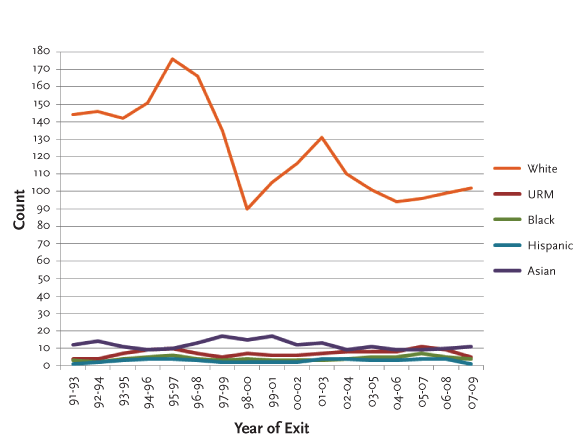
Figure 4.6.2
Faculty who have left 19912009, by race/ethnicity and gender
(Rolling 3-year sums)
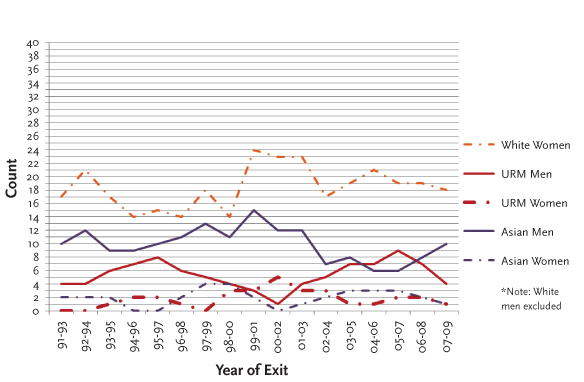
Figure 4.6.3
URM faculty who have left, 19912009
(Rolling 3-year sums)
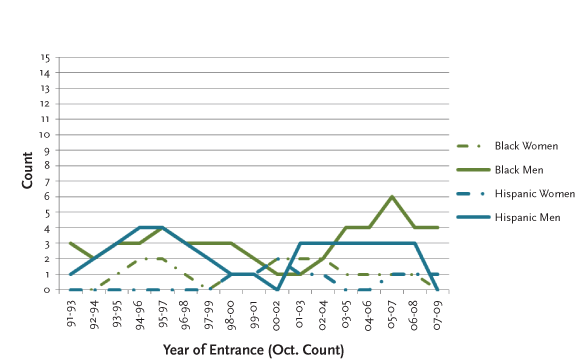
Appendix 5
Salary Analysis
- 5.1 OLS regression model results of effect of URM status on salary (natural log).
All current faculty as of January 2009. - 5.2 OLS regression model results of effect of URM on salary (natural log),
science & engineering subsample with research volume.
Table 5.1 OLS regression model results of effect of URM status on salary (natural log).
All current faculty as of January 2009.
| Model 1 | Model 2 | Model 3 | Model 4 | Model 5 | Model 6 |
Department controls |
| X | X | X | X | X |
5yr cohort controls |
| X | X | X | X | X |
URM | 0.082 | 0.034 | 0.032 | 0.041* |
|
|
| (0.050) | (0.030) | (0.027) | (0.018) |
|
|
Asian | 0.090** | 0.016 | 0.018 | 0.005 | 0.001 | 0.005 |
| (0.031) | (0.021) | (0.019) | (0.015) | (0.015) | (0.015) |
Female | 0.101*** | 0.000 | 0.011 | 0.002 | 0.000 | 0.002 |
| (0.027) | (0.015) | (0.014) | (0.011) | (0.011) | (0.011) |
Age (centered) |
| 0.015*** | 0.001 | 0.001 | 0.001 | 0.001 |
|
| (0.001) | (0.002) | (0.001) | (0.001) | (0.001) |
Age (centered) squared |
| 0.000*** | 0.000*** | 0.000 | 0.000 | 0.000 |
|
| (0.000) | (0.000) | (0.000) | (0.000) | (0.000) |
Time at MIT |
| 0.001 | 0.002*** | 0.000 | 0.000 | 0.000 |
|
| (0.001) | (0.001) | (0.000) | (0.000) | (0.000) |
Time at MIT squared |
| 0.000 | 0.000 | 0.000 | 0.000 | 0.000 |
|
| (0.000) | (0.000) | (0.000) | (0.000) | (0.000) |
Non-U.S. origin |
| 0.022 | 0.025 | 0.018 |
| 0.018 |
|
| (0.014) | (0.013) | (0.010) |
| (0.010) |
Started as AWOT |
|
| 0.071** | 0.022 | 0.023 | 0.022 |
|
|
| (0.027) | (0.021) | (0.021) | (0.021) |
Started as Associate |
|
| 0.115*** | 0.006 | 0.006 | 0.006 |
|
|
| (0.032) | (0.028) | (0.028) | (0.028) |
Started as Full |
|
| 0.350*** | 0.185*** | 0.183*** | 0.185*** |
|
|
| (0.036) | (0.029) | (0.029) | (0.029) |
Current rank: Asst |
|
|
| 0.505*** | 0.509*** | 0.505*** |
|
|
|
| (0.026) | (0.026) | (0.027) |
Current rank: AWOT |
|
|
| 0.380*** | 0.381*** | 0.380*** |
|
|
|
| (0.023) | (0.023) | (0.023) |
Current rank: Assoc |
|
|
| 0.228*** | 0.227*** | 0.228*** |
|
|
|
| (0.020) | (0.020) | (0.020) |
Previous admin. Experience |
|
|
| 0.171*** | 0.171*** | 0.171*** |
|
|
|
| (0.016) | (0.016) | (0.016) |
URM * non-U.S. origin |
|
|
|
| 0.031 |
|
|
|
|
|
| (0.027) |
|
URM * U.S. origin |
|
|
|
| 0.056* |
|
|
|
|
|
| (0.023) |
|
Black |
|
|
|
|
| 0.044* |
|
|
|
|
|
| (0.019) |
Hispanic |
|
|
|
|
| 0.044 |
|
|
|
|
|
| (0.031) |
R-squared | 0.030 | 0.696 | 0.739 | 0.839 | 0.838 | .839 |
Observations | 834 | 834 | 834 | 834 | 834 | 834 |
* p<0.05, ** p<0.01, *** p<0.001
Robust standard errors are in parentheses.
Note: Post-estimation t-tests confirm that differences between the Black/Hispanic and U.S. origin/non-U.S. origin coefficients are
not statistically significant.
Note: A Blinder-Oaxaca decomposition confirms that the uncontrolled salary gap in favor of non-URM is explained by a few
covariates, department and cohort.
Table 5.2 OLS regression model results of effect of URM on salary (natural log),
science and engineering subsample with research volume
| Model 1 |
Model 2 |
Model 3 |
Model 4 |
Model 5 |
Model 6 |
Model 7 |
Department controls |
| X | X | X | X | X | X |
5yr cohort controls |
| X | X | X | X | X | X |
URM | 0.096 | 0.001 | 0.010 | 0.009 | 0.018 |
|
|
(0.062) | (0.048) | (0.046) | (0.034) | (0.032) |
|
|
|
Asian | 0.055 | 0.017 | 0.011 | 0.009 | 0.012 | 0.018 | 0.013 |
| (0.033) | (0.021) | (0.018) | (0.015) | (0.015) | (0.014) | (0.015) |
Female | 0.074* | 0.021 | 0.025 | 0.011 | 0.018 | 0.014 | 0.018 |
| (0.032) | (0.018) | (0.016) | (0.012) | (0.012) | (0.012) | (0.012) |
Age (centered) |
| 0.017*** | 0.003 | 0.001 | 0.001 | 0.001 | 0.001 |
|
| (0.002) | (0.002) | (0.002) | (0.002) | (0.002) | (0.002) |
Age (centered) squared |
| 0.000*** | 0.000*** | 0.000* | 0.000* | 0.000* | 0.000* |
|
| (0.000) | (0.000) | (0.000) | (0.000) | (0.000) | (0.000) |
Time at MIT |
| 0.002 | 0.003** | 0.000 | 0.000 | 0.000 | 0.000 |
|
| (0.001) | (0.001) | (0.001) | (0.001) | (0.001) | (0.001) |
Time at MIT squared |
| 0.000 | 0.000 | 0.000 | 0.000 | 0.000 | 0.000 |
|
| (0.000) | (0.000) | (0.000) | (0.000) | (0.000) | (0.000) |
Non-U.S. origin |
| 0.028 | 0.030* | 0.019 | 0.016 |
| 0.016 |
|
| (0.017) | (0.015) | (0.012) | (0.012) |
| (0.012) |
Started as AWOT |
|
| 0.072* | 0.026 | 0.027 | 0.028 | 0.027 |
|
|
| (0.034) | (0.026) | (0.025) | (0.025) | (0.025) |
Started as Associate |
|
| 0.110** | 0.009 | 0.002 | 0.005 | 0.002 |
|
|
| (0.042) | (0.028) | (0.028) | (0.029) | (0.028) |
Started as Full |
|
| 0.325*** | 0.168*** | 0.164*** | 0.163*** | 0.165*** |
|
|
| (0.036) | (0.030) | (0.029) | (0.029) | (0.029) |
Current rank: Asst |
|
|
| 0.465*** | 0.432*** | 0.441*** | 0.432*** |
|
|
|
| (0.030) | (0.029) | (0.029) | (0.029) |
Current rank: AWOT |
|
|
| 0.353*** | 0.334*** | 0.336*** | 0.334*** |
|
|
|
| (0.025) | (0.025) | (0.025) | (0.025) |
Current rank: Assoc |
|
|
| 0.194*** | 0.175*** | 0.176*** | 0.175*** |
|
|
|
| (0.021) | (0.018) | (0.018) | (0.018) |
Previous admin. experience |
|
|
| 0.178*** | 0.165*** | 0.165*** | 0.165*** |
|
|
|
| (0.018) | (0.019) | (0.019) | (0.019) |
ResVolumeEngSciLog |
|
|
|
| 0.023*** | 0.023*** | 0.023*** |
|
|
|
|
| (0.006) | (0.006) | (0.006) |
URM * non-U.S. origin |
|
|
|
|
| 0.002 |
|
|
|
|
|
|
| (0.046) |
|
URM * U.S. origin |
|
|
|
|
| 0.042 |
|
|
|
|
|
|
| (0.037) |
|
Black |
|
|
|
|
|
| 0.021 |
|
|
|
|
|
|
| (0.032) |
Hispanic |
|
|
|
|
|
| 0.022 |
|
|
|
|
|
|
| (0.055) |
R-squared | 0.022 | 0.611 | 0.671 | 0.800 | 0.809 | 0.808 | .809 |
Observations | 489 | 489 | 489 | 489 | 489 | 489 | 489 |
* p<0.05, ** p<0.01, *** p<0.001
Robust standard errors are in parentheses.
Note: Post-estimation t-tests confirm that differences between the Black/Hispanic and US origin/non-US origin coefficients are not statistically significant.
Previous:
References for Research Report
Footnotes:
16 Categories in bold were pre-assigned from institutional data.
17 One Native American faculty member is excluded from this table.
L. Rafael Reif
Office of the Provost
Room 3-208
Massachusetts Institute of Technology
77 Massachusetts Avenue
Cambridge, MA 02139-4307
(617) 253-4500 phone
(617) 253-8812 fax

